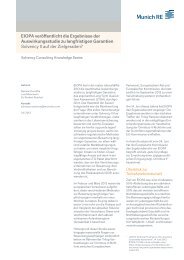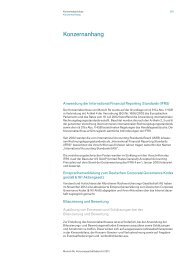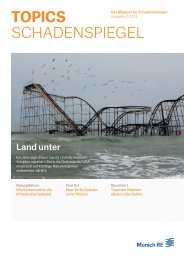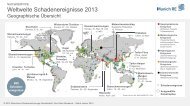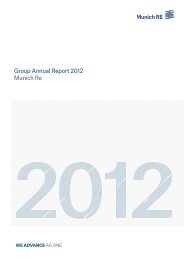Munich Re Group Annual Report 2006 (PDF, 1.8
Munich Re Group Annual Report 2006 (PDF, 1.8
Munich Re Group Annual Report 2006 (PDF, 1.8
Create successful ePaper yourself
Turn your PDF publications into a flip-book with our unique Google optimized e-Paper software.
<strong>Munich</strong> <strong>Re</strong> <strong>Group</strong> <strong>Annual</strong> <strong>Re</strong>port <strong>2006</strong> General information_Glossary<br />
Glossary A – C<br />
Accumulation<br />
The situation where a number of risks insured or reinsured with the<br />
same company may be affected simultaneously by a loss event.<br />
Actuary<br />
Qualified expert who analyses problems from the area of insurance,<br />
home loans, investments and pensions using methods of probability<br />
theory and financial mathematics, and develops solutions with due<br />
regard to legal and economic parameters.<br />
Affiliated company<br />
In the consolidated financial statements of <strong>Munich</strong> <strong>Re</strong>insurance<br />
Company (the parent) all companies are deemed affiliated companies<br />
in which <strong>Munich</strong> <strong>Re</strong>insurance Company holds the majority<br />
of the voting rights either directly or indirectly.<br />
Alternative risk financing<br />
Utilising the capacity of the capital markets to cover insurance risks.<br />
An example is the securitisation of natural catastrophe risks that can<br />
no longer be borne in full by the insurance and reinsurance industry.<br />
Amortised cost<br />
The amount at which a financial asset or financial liability is measured<br />
at initial recognition minus principal repayments, plus or minus<br />
the cumulative amortisation using the effective interest method or<br />
any differences between the initial amount and the maturity amount,<br />
and minus any write-down for impairment or uncollectibility.<br />
Asset-liability management<br />
Management of a business in a way that coordinates decisions on<br />
assets and liabilities. Specifically, it is the ongoing process of formulating,<br />
implementing, monitoring, and revising strategies related to<br />
assets and liabilities in an attempt to achieve financial objectives for<br />
a given set of risk tolerances and constraints.<br />
Asset management<br />
Management of an investment portfolio on the basis of risk and<br />
return considerations. It covers both the preparation and implementation<br />
of investment decisions regarding assets and the management<br />
of special funds.<br />
Assistance<br />
Range of services going beyond the traditional scope of insurance<br />
and cost reimbursement. The idea of assistance services is to help<br />
claimants quickly and unbureaucratically in the event of a loss occurrence,<br />
taking care of the necessary arrangements to remedy the<br />
situation.<br />
Associate<br />
Companies on whose financial and operating decisions a significant<br />
(but not a controlling) influence can be exercised, regardless of<br />
whether this influence is actually exercised or not. A significant influence<br />
is presumed if the proportion of voting rights lies between 20%<br />
and 50%. Investments in associates are valued according to the <br />
equity method.<br />
Balanced scorecard<br />
Strategy-implementation tool in which strategic objectives and initiatives<br />
(financial and non-financial) are set out in a table and linked<br />
with one another. Short-term milestones help in monitoring the<br />
achievement of objectives.<br />
Bornhuetter-Ferguson method<br />
Standard actuarial method used to estimate the reserves needed for<br />
future claims expenditure resulting from losses that have already<br />
occurred but are not yet sufficiently specific. With this method, the<br />
overall loss expected is determined on the basis of historical data on<br />
the run-off of losses in the portfolio and an independent assessment<br />
by the insurer. These parameters are given different weightings,<br />
depending on the information available on the status of the losses.<br />
Capital Asset Pricing Model (CAPM)<br />
Capital market model based on the portfolio theory, used to evaluate<br />
securities. The CAPM expands the portfolio theory to include the<br />
question of which part of a security’s overall risk cannot be eliminated<br />
by means of risk diversification and explains how investment<br />
opportunities entailing risk are assessed in the capital markets.<br />
Accordingly, in efficient markets where prices already incorporate all<br />
the information, a greater return can only be achieved by assuming<br />
more risk.<br />
Captive<br />
An insurance company established as a subsidiary of one or more<br />
industrial/trading companies or groups mainly for the purpose of<br />
insuring the risks of these companies and their affiliates.<br />
Cash flow statement<br />
Statement disclosing the origin and utilisation of cash during the<br />
financial year. It shows the change in liquid funds separately according<br />
to cash flows from operating activities, cash flows from investing<br />
activities and cash flows from financing activities.<br />
219



